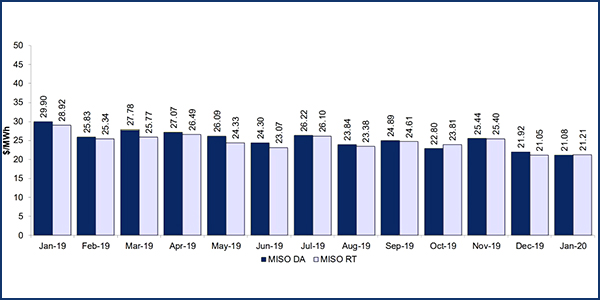By Amanda Durish Cook
CARMEL, Ind. — A mild winter across the Midwest footprint made for an easy January for MISO operators, stakeholders heard last week.
“Load is down; temperatures for the footprint are higher than usual. It’s been a mild winter so far,” Executive Director of Energy Operations Rob Benbow reported at a Reliability Subcommittee meeting Thursday. He added that MISO months before had forecasted a warm winter.
Load for the month averaged almost 76 GW, down from 80.2 GW in January 2019. The month’s 94.4-GW peak load on Jan. 21 was also significantly lower than the 101-GW peak experienced last January. MISO staff in fall predicted a 104-GW peak, with the highest risk of emergencies in January. (See MISO Taking Pains to Prepare for Moderate Winter.)
Real-time prices were similarly down at an average of $21.21/MWh, a 27% decrease year over year.
January marked MISO’s seventh straight month without any maximum generation alerts, warnings or events. Between May and June 2019, the RTO experienced seven maximum generation actions. MISO had not experienced an emergency-free January since 2017.
Benbow said MISO South was under a severe weather alert Jan. 10-11 as a band of tornados and strong winds traveled across eastern Texas, Louisiana and Alabama. He said that while the region experienced some transmission losses over the two days, MISO operators were able to work around them and avoid escalation.
Nov. 13 Revisit
So far, MISO’s only notable cold-weather event remains outside the winter months, when the Southeastern U.S. was hit with a cold snap Nov. 13 that sent temperatures plummeting 25 degrees Fahrenheit below normal in some cities.
“We had a relatively warm summer and fall, then we got this cold weather blast,” said Gerald Rusin, senior adviser for MISO South operations. “MISO did see the cold weather coming and was prepared for it.” The RTO experienced about 5 GW of capacity losses in the face of cold weather-related outages and contingencies.
However, SPP also declared a Safe Operating Mode (SOM) and requested that MISO limit flows to 1,500 MW on the regional dispatch transfer limit between its Midwest and South regions, down from the usual 3,000 MW southbound and 2,500 MW northbound limits. The RTOs’ SOM joint agreement is meant to keep an abnormal operating event in either grid operator’s territory from progressing into an emergency.
“Did we understand that it was going to be a challenging day? Yes. Did we expect SPP to request to cut the limit by half? No,” Benbow told stakeholders.
MISO’s Independent Market Monitor in January said he continues to investigate whether SPP should have made an intermediate move, including requesting unit redispatch or transmission loading relief, before calling for the “sledgehammer” transfer limit derate. The Monitor said SPP gave little warning before the request, leaving MISO with significant congestion costs. (See “Monitor Examining SPP’s Fall Transfer Derate,” MISO Market Subcommittee Briefs: Jan. 8, 2020.)
As a result of the incident, Rusin said the RTOs have agreed to a “refresher training” for their control room operators on how to use their congestion management tool for flowgates.
Rusin also said MISO is taking pains to ensure that neighboring reliability coordinators communicate system conditions to one another.
“It’s just bringing all the RCs together before an event occurs to make sure they’re talking to each other,” Rusin said.
MISO also said it needs to ensure that when SPP requests a new regional dispatch transfer limit, any ensuing temporary calculations are reflected in all of MISO’s impacted market processes.





